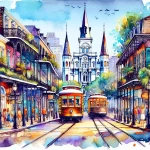New Orleans, a city deeply rooted in rich cultural heritage, showcases an impressive array of churches that have withstood the test of time. These architectural marvels transcend their roles as places of worship, serving as living testaments to the city’s diverse history and spiritual fabric.
In This Article
TL;DR
- New Orleans churches blend architectural styles, reflecting the city’s multicultural influences.
- These sacred spaces have shaped the spiritual and cultural fabric of the local community.
- Notable churches like St. Louis Cathedral and St. Augustine Church are must-visit destinations for their historical and artistic significance.
St. Louis Cathedral: A Symbol of New Orleans
Towering majestically over Jackson Square, St. Louis Cathedral is an enduring symbol of New Orleans‘ French and Spanish colonial heritage. Constructed in 1794, this iconic cathedral boasts a striking blend of Renaissance and Spanish architectural styles, with its imposing façade adorned with intricate carvings and a trio of spires piercing the skyline.
Beyond its architectural grandeur, St. Louis Cathedral holds a revered place in the city’s cultural and spiritual life. It has witnessed countless baptisms, weddings, and funerals, serving as a sacred gathering place for generations of New Orleanians. Notable events, such as the annual Christmas Eve Bonfires and the St. Joseph’s Day Altar, have become cherished traditions deeply rooted in the cathedral’s history.
Our Lady of Guadalupe Church: The Old Mortuary Chapel
Located in the heart of the French Quarter, Our Lady of Guadalupe Church stands as a testament to the city’s rich Catholic heritage. Originally constructed in 1826 as a mortuary chapel, this historic church has undergone several transformations, each layer adding to its unique character.
The church’s interior is a feast for the senses, adorned with vibrant murals, intricate tilework, and ornate altars that transport visitors to a bygone era. The centerpiece, a striking statue of Our Lady of Guadalupe, serves as a powerful reminder of the church’s dedication to the patron saint of the Americas.
Beyond its religious significance, Our Lady of Guadalupe Church plays an active role in the community, hosting cultural events, art exhibitions, and outreach programs that celebrate the city’s diverse heritage.
St. Augustine Church: Heart of Treme
Situated in the historic Treme neighborhood, St. Augustine Church holds a special place in the hearts of New Orleans’ African American community. Established in 1842, it is the oldest African American Catholic parish in the United States, a symbol of resilience and perseverance in the face of adversity.
The church’s architectural style is a harmonious blend of Greek Revival and Creole influences, with its striking façade and towering steeple serving as a beacon for the community. Inside, the sanctuary is adorned with intricate stained-glass windows and ornate woodwork, creating a serene and reverent atmosphere.
St. Augustine Church played a pivotal role in the civil rights movement, serving as a gathering place for activists and a sanctuary for those seeking solace and strength. Today, it continues to be a vibrant hub of spiritual and cultural activities, celebrating the rich heritage of the African American community in New Orleans.
St. Mary’s Assumption Church: German Catholic Heritage
Located in the Irish Channel, St. Mary’s Assumption Church stands as a testament to the city’s German Catholic heritage. Established in 1858 by German immigrants, the church’s architectural style reflects the influence of the Baroque and Renaissance periods, with its imposing façade and ornate interior details.
Upon entering the sanctuary, visitors are greeted by a breathtaking sight – soaring ceilings adorned with intricate frescoes, stained-glass windows that cast a kaleidoscope of colors, and ornate altars that showcase the craftsmanship of skilled artisans. The church’s interior is a true masterpiece, a harmonious blend of art and spirituality.
Beyond its architectural splendor, St. Mary’s Assumption Church plays a vital role in preserving and celebrating the city’s German heritage. Annual festivals and cultural events held at the church provide a vibrant platform for the community to come together and honor their roots.
First Grace United Methodist Church: A Model of Integration
Located in the Central City neighborhood, First Grace United Methodist Church stands as a beacon of hope and unity. Founded in the midst of the civil rights era, this church was born out of a merger between two congregations – one predominantly white and the other predominantly black – in a bold move towards racial integration.
The church’s architectural style is a harmonious blend of modern and traditional elements, with its sleek lines and soaring ceilings creating a sense of openness and inclusivity. Inside, the sanctuary is adorned with vibrant stained-glass windows and intricate woodwork, reflecting the diverse cultural influences that have shaped the church’s community.
First Grace United Methodist Church has been at the forefront of social justice initiatives, advocating for equality, education, and community empowerment. Its outreach programs and community events have fostered a spirit of unity and understanding, making it a true model of integration and inclusivity in New Orleans.
St. Roch Chapel: A Shrine of Promises
Tucked away in the St. Roch neighborhood, the St. Roch Chapel stands as a testament to the unwavering faith and resilience of the New Orleans community. This unassuming chapel, dedicated to St. Roch, the patron saint of plagues and epidemics, has become a revered pilgrimage site for those seeking solace and healing.
The chapel’s interior is a tapestry of devotion, adorned with countless ex-voto offerings – intricate sculptures, paintings, and personal mementos left by devotees in gratitude for answered prayers. These offerings, each with its own story, create a powerful and moving atmosphere that transcends religious boundaries.
During times of crisis, such as the yellow fever epidemics of the 19th century and the devastating aftermath of Hurricane Katrina, the St. Roch Chapel has served as a beacon of hope, offering solace and strength to those in need. Its enduring presence in the community is a testament to the resilience and faith that have sustained New Orleanians through even the darkest of times.
Holy Trinity Greek Orthodox Cathedral: Byzantine Beauty
Located in the Warehouse District, the Holy Trinity Greek Orthodox Cathedral stands as a magnificent example of Byzantine architecture in New Orleans. Established in 1864 by Greek immigrants, this cathedral has become a cherished cultural and spiritual hub for the city’s Greek community.
The cathedral’s exterior is a striking blend of traditional Byzantine elements, with its iconic domes and intricate brickwork creating a sense of grandeur and majesty. Inside, visitors are transported to a world of opulence and spirituality, with soaring ceilings adorned with intricate frescoes, ornate iconography, and glittering chandeliers that cast a warm, ethereal glow.
Beyond its architectural splendor, the Holy Trinity Greek Orthodox Cathedral plays a vital role in preserving and celebrating the rich cultural heritage of the Greek community in New Orleans. Annual festivals and events held at the cathedral provide a vibrant platform for the community to come together, share their traditions, and celebrate their roots.
Preservation and Continuity: Safeguarding New Orleans’ Religious Heritage
As the city continues to evolve, preserving the historic churches of New Orleans has become a paramount concern. These sacred spaces are not only architectural gems but also repositories of cultural memory, holding the stories and traditions that have shaped the city’s unique identity.
Local communities and heritage organizations have rallied together, spearheading efforts to restore and maintain these iconic structures. From fundraising campaigns to hands-on restoration projects, these initiatives ensure that the churches’ rich histories and architectural splendor are preserved for generations to come.
The preservation of New Orleans’ churches is not merely an exercise in nostalgia; it is a vital step in safeguarding the city’s cultural tapestry and ensuring that these sacred spaces continue to serve as beacons of spirituality and community for years to come. As visitors explore these architectural wonders, they are not only witnessing history but also contributing to the continuity of a legacy that has defined the very soul of New Orleans.






